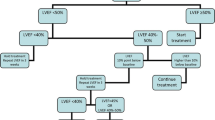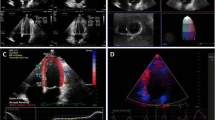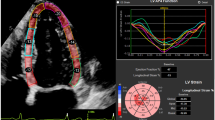Abstract
Patients with cancer can present with difficult management issues, as the medicine can sometimes cause sequelae destructive to healthy tissue. As this population lives longer, cardiotoxic effects are beginning to emerge, but the early recognition of this signal can prove difficult, with too late a recognition leading to lifelong cardiac impairment and dysfunction. Cardio-oncology can bridge this difficulty, and echocardiography and its newer imaging abilities are proving efficacious in this population. This article will address common sequelae of cardiotoxic treatment regimens and offer recommendations for echocardiographic surveillance. We recommend echocardiography, preferably three-dimensional and strain imaging, to monitor for cardiotoxic myocardial effects before, during, and after chemotherapy with cardiotoxic drug regimens, particularly anthracycline derivatives. A reduction in left ventricular (LV) global longitudinal strain in all patients, or reduction in LV global circumferential strain or global radial strain in patients at intermediate to high risk for cardiotoxicity, despite normal LV ejection fraction warrants a clinical assessment on the benefits of continuing cardiotoxic chemotherapeutic agents. Lifelong surveillance using echocardiography for cardiotoxicity and radiation-related valvular, pericardial, and coronary artery disease is prudent.



Similar content being viewed by others
References
Papers of particular interest, published recently, have been highlighted as: • Of importance •• Of major importance
Agboola SO, Ju W, Elfiky A, et al. The effect of technology-based interventions on pain, depression, and quality of life in patients with cancer: a systematic review of randomized controlled trials. J Med Internet Res. 2015;17(3), e65.
Evangelista A, Galuppo V, Mendez J, et al. Hand-held cardiac ultrasound screening performed by family doctors with remote expert support interpretation. Heart. 2016;102(5):376–82.
Lal H, Kolaja KL, Force T. Cancer genetics and the cardiotoxicity of the therapeutics. J Am Coll Cardiol. 2013;61(3):267–74.
Mor-Avi V, Lang RM. Is echocardiography reliable for monitoring the adverse cardiac effects of chemotherapy? J Am Coll Cardiol. 2013;61(1):85–7.
Thavendiranathan P, Poulin F, Lim KD, et al. Use of myocardial strain imaging by echocardiography for the early detection of cardiotoxicity in patients during and after cancer chemotherapy: a systematic review. J Am Coll Cardiol. 2014;63(25 Pt A):2751–68.
Otterstad JE, Froeland G, St John Sutton M, et al. Accuracy and reproducibility of biplane two-dimensional echocardiographic measurements of left ventricular dimensions and function. Eur Heart J. 1997;18(3):507–13.
Aurigemma GP, Tighe DA. Echocardiography and reversible left ventricular dysfunction. Am J Med. 2006;119(1):18–21.
Abdelrahman M, McCarthy MT, Yusof H, et al. Successful capecitabine rechallenge following 5-fluorouracil-induced Takotsubo syndrome. Oxf Med Case Rep. 2016;2016(3):47–50.
Shalbaf A, Behnam H, Alizade-Sani Z, et al. Automatic classification of left ventricular regional wall motion abnormalities in echocardiography images using nonrigid image registration. J Digit Imaging. 2013;26(5):909–19.
Pudil R, Horacek JM, Strasova A, et al. Monitoring of the very early changes of left ventricular diastolic function in patients with acute leukemia treated with anthracyclines. Exp Oncol. 2008;30(2):160–2.
Stoddard MF, Seeger J, Liddell NE, et al. Prolongation of isovolumetric relaxation time as assessed by Doppler echocardiography predicts doxorubicin-induced systolic dysfunction in humans. J Am Coll Cardiol. 1992;20(1):62–9.
Shakir DK, Rasul KI. Chemotherapy induced cardiomyopathy: pathogenesis, monitoring and management. J Clin Med Res. 2009;1(1):8–12.
Albini A, Pennesi G, Donatelli F, et al. Cardiotoxicity of anticancer drugs: the need for cardio-oncology and cardio-oncological prevention. J Natl Cancer Inst. 2010;102(1):14–25.
Huang RS, Duan S, Kistner EO, et al. Genetic variants contributing to daunorubicin-induced cytotoxicity. Cancer Res. 2008;68(9):3161–8.
Pai VB, Nahata MC. Cardiotoxicity of chemotherapeutic agents: incidence, treatment and prevention. Drug Saf. 2000;22(4):263–302.
Onitilo AA, Engel JM, Stankowski RV. Cardiovascular toxicity associated with adjuvant trastuzumab therapy: prevalence, patient characteristics, and risk factors. Ther Adv Drug Saf. 2014;5(4):154–66.
Herrmann J, Lerman A, Sandhu NP, et al. Evaluation and management of patients with heart disease and cancer: cardio-oncology. Mayo Clin Proc. 2014;89(9):1287–306.
Ezaz G, Long JB, Gross CP, et al. Risk prediction model for heart failure and cardiomyopathy after adjuvant trastuzumab therapy for breast cancer. J Am Heart Assoc. 2014;3(1), e000472.
Cardinale D, Sandri MT, Colombo A, et al. Prognostic value of troponin I in cardiac risk stratification of cancer patients undergoing high-dose chemotherapy. Circulation. 2004;109(22):2749–54.
Yingchoncharoen T, Agarwal S, Popovic ZB, et al. Normal ranges of left ventricular strain: a meta-analysis. J Am Soc Echocardiogr. 2013;26(2):185–91. This meta-analysis establishes normal values of speckle tracking echocardiography strain.
Sawaya H, Sebag IA, Plana JC, et al. Early detection and prediction of cardiotoxicity in chemotherapy-treated patients. Am J Cardiol. 2011;107(9):1375–80.
Poterucha JT, Kutty S, Lindquist RK, et al. Changes in left ventricular longitudinal strain with anthracycline chemotherapy in adolescents precede subsequent decreased left ventricular ejection fraction. J Am Soc Echocardiogr. 2012;25(7):733–40.
Pizzino F, Vizzari G, Qamar R, et al. Multimodality imaging in cardiooncology. J Oncol. 2015;2015:263950.
Negishi K, Negishi T, Hare JL, et al. Independent and incremental value of deformation indices for prediction of trastuzumab-induced cardiotoxicity. J Am Soc Echocardiogr. 2013;26(5):493–8.
Kaneko S, Tham EB, Haykowsky MJ, et al. Impaired left ventricular reserve in childhood cancer survivors treated with anthracycline therapy. 2016. Pediatr Blood Cancer.
Stoodley PW, Richards DA, Boyd A, et al. Altered left ventricular longitudinal diastolic function correlates with reduced systolic function immediately after anthracycline chemotherapy. Eur Heart J Cardiovasc Imaging. 2013;14(3):228–34.
Lang RM, Badano LP, Mor-Avi V, et al. Recommendations for cardiac chamber quantification by echocardiography in adults: an update from the American Society of Echocardiography and the European Association of Cardiovascular Imaging. J Am Soc Echocardiogr. 2015;28(1):1–39.e14.
Dorup I, Levitt G, Sullivan I, et al. Prospective longitudinal assessment of late anthracycline cardiotoxicity after childhood cancer: the role of diastolic function. Heart. 2004;90(10):1214–6.
Civelli M, Cardinale D, Martinoni A, et al. Early reduction in left ventricular contractile reserve detected by dobutamine stress echo predicts high-dose chemotherapy-induced cardiac toxicity. Int J Cardiol. 2006;111(1):120–6.
Seidman A, Hudis C, Pierri MK, et al. Cardiac dysfunction in the trastuzumab clinical trials experience. J Clin Oncol. 2002;20(5):1215–21.
Thavendiranathan P, Grant AD, Negishi T, et al. Reproducibility of echocardiographic techniques for sequential assessment of left ventricular ejection fraction and volumes: application to patients undergoing cancer chemotherapy. J Am Coll Cardiol. 2013;61(1):77–84. This study establishes that 3-dimensional as opposed to 2-dimensional echocardiography for measurement of ejection fraction is the more appropriate technique for serial evaluation of left ventricular systolic funtion in patients undergoing cancer chemotherapy.
Walker J, Bhullar N, Fallah-Rad N, et al. Role of three-dimensional echocardiography in breast cancer: comparison with two-dimensional echocardiography, multiple-gated acquisition scans, and cardiac magnetic resonance imaging. J Clin Oncol. 2010;28(21):3429–36.
Barendswaard EC, Prpic H, Van der Wall EE, et al. Right ventricle wall motion abnormalities in patients treated with chemotherapy. Clin Nucl Med. 1991;16(7):513–6.
Grover S, Leong DP, Chakrabarty A, et al. Left and right ventricular effects of anthracycline and trastuzumab chemotherapy: a prospective study using novel cardiac imaging and biochemical markers. Int J Cardiol. 2013;168(6):5465–7.
Shah NP, Wallis N, Farber HW, et al. Clinical features of pulmonary arterial hypertension in patients receiving dasatinib. Am J Hematol. 2015;90(11):1060–4.
Lemarie J, Huttin O, Girerd N, et al. Usefulness of speckle-tracking imaging for right ventricular assessment after acute myocardial infarction: a magnetic resonance imaging/echocardiographic comparison within the relation between aldosterone and cardiac remodeling after myocardial infarction study. J Am Soc Echocardiogr. 2015;28(7):818–27.e4.
Park JH, Negishi K, Kwon DH, et al. Validation of global longitudinal strain and strain rate as reliable markers of right ventricular dysfunction: comparison with cardiac magnetic resonance and outcome. J Cardiovasc Ultrasound. 2014;22(3):113–20. This study validates strain derived by echocardiography as reliable method to assess right ventricular function. Strain imaging is compared to cardiac magnetic resonance imaging.
Lisi M, Cameli M, Righini FM, et al. RV longitudinal deformation correlates with myocardial fibrosis in patients with end-stage heart failure. JACC Cardiovasc Imaging. 2015;8(5):514–22.
Portnoy SG, Rudski LG. Echocardiographic evaluation of the right ventricle: a 2014 perspective. Curr Cardiol Rep. 2015;17(4):21.
Shimada YJ, Shiota M, Siegel RJ, et al. Accuracy of right ventricular volumes and function determined by three-dimensional echocardiography in comparison with magnetic resonance imaging: a meta-analysis study. J Am Soc Echocardiogr. 2010;23(9):943–53.
Tanindi A, Demirci U, Tacoy G, et al. Assessment of right ventricular functions during cancer chemotherapy. Eur J Echocardiogr. 2011;12(11):834–40.
Murbraech K, Wethal T, Smeland KB, et al. Valvular dysfunction in lymphoma survivors treated with autologous stem cell transplantation: a national cross-sectional study. JACC Cardiovasc Imaging. 2016;9(3):230–9.
Cozzarin A, Cianciulli TF, Saccheri MC, et al. Severe mitral regurgitation after radiotherapy. Echocardiography. 2014;31(2):E37–40.
Sharma A, Minhas HS, Sakhuja P, et al. Left atrial primary B cell lymphoma presenting with mitral regurgitation. J Card Surg. 2012;27(3):300–3.
Karanth NV, Roy A, Joseph M, et al. Utility of prechemotherapy echocardiographical assessment of cardiac abnormalities. Support Care Cancer. 2011;19(12):2021–6.
Santos AR, Stuart B, Cotrim C, et al. Carcinoid heart—case report. Rev Port Cardiol. 2012;31(10):661–5.
Schmitt CJ, Dietrich S, Ho AD, et al. Replacement of conventional doxorubicin by pegylated liposomal doxorubicin is a safe and effective alternative in the treatment of non-Hodgkin’s lymphoma patients with cardiac risk factors. Ann Hematol. 2012;91(3):391–7.
Latib A, Montorfano M, Figini F, et al. Percutaneous valve replacement in a young adult for radiation-induced aortic stenosis. J Cardiovasc Med (Hagerstown). 2012;13(6):397–8.
Pugliatti P, Donato R, Grimaldi P, et al. Extrinsic pulmonary stenosis in primary mediastinal B-cellular lymphoma. J Clin Ultrasound. 2015;43(1):68–70.
Zencirci E, Gunduz S, Zencirci AE, et al. Echocardiography in imaging an extremely rare cause of extrinsic pulmonary stenosis: rapidly progressive primary mediastinal embryonal carcinoma. Ann Thorac Surg. 2012;94(5):e113–4.
Lange SA, Ebner B, Wess A, et al. Echocardiography signs of early cardiac impairment in patients with breast cancer and trastuzumab therapy. Clin Res Cardiol. 2012;101(6):415–26.
Karabay CY, Kocabay G, Kalayci A, et al. Mitral regurgitation due to papillary muscle dyssynchrony during trastuzumab treatment. Cardiology. 2010;117(4):296–300.
Todaro MC, Oreto L, Qamar R, et al. Cardioncology: state of the heart. Int J Cardiol. 2013;168(2):680–7.
Ewer MS, Vooletich MT, Durand JB, et al. Reversibility of trastuzumab-related cardiotoxicity: new insights based on clinical course and response to medical treatment. J Clin Oncol. 2005;23(31):7820–6.
Gunaydin ZY, Bektas O, Ciltas A, et al. Does Trastuzumab cause permanent severe mitral regurgitation? Int J Cardiol. 2015;182:8–9.
Klein AL, Abbara S, Agler DA, et al. American Society of Echocardiography clinical recommendations for multimodality cardiovascular imaging of patients with pericardial disease: endorsed by the Society for Cardiovascular Magnetic Resonance and Society of Cardiovascular Computed Tomography. J Am Soc Echocardiogr. 2013;26(9):965–1012.e15.
Author information
Authors and Affiliations
Corresponding author
Ethics declarations
Conflict of Interest
Wendy J. Bottinor, Christopher K. Migliore, Carrie A. Lenneman, and Marcus F. Stoddard declare that they have no conflict of interest.
Human and Animal Rights and Informed Consent
This article does not contain any studies with human or animal subjects performed by any of the authors.
Additional information
Wendy J. Bottinor and Christopher K. Migliore are co-first authors on this paper.
This article is part of the Topical Collection on Echocardiography
Rights and permissions
About this article
Cite this article
Bottinor, W.J., Migliore, C.K., Lenneman, C.A. et al. Echocardiographic Assessment of Cardiotoxic Effects of Cancer Therapy. Curr Cardiol Rep 18, 99 (2016). https://doi.org/10.1007/s11886-016-0776-z
Published:
DOI: https://doi.org/10.1007/s11886-016-0776-z




